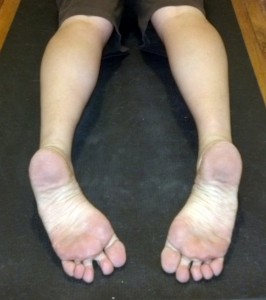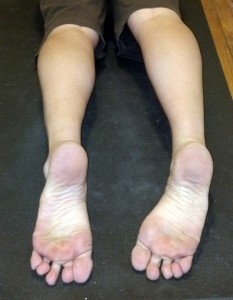The position of the ankles in upward facing dog, a ubiquitous yoga pose, can have a major effect on the sacroiliac joints of the pelvis.
Upward facing dog is a yoga pose most often linked to a form of sun salute that involves a flowing transition from chaturanga dandasana to upward facing dog before moving backward into downward facing dog.
Upward facing dog is a deep backbend that is essentially a cobra pose with the thighs elevated off of the floor.
As a student, I love surya namaskar A with jumpbacks. My home practice always begins with five surya namaskar A and three surya namaskar B (after all these years I still do the ashtanga warm-up, which takes about twenty minutes, with some other stuff thrown in) which means I move through the transition from chaturanga to upward facing dog eleven times in less than ten minutes.
This type of sun salute makes me so happy.
The power of chaturanga where I feel strong is followed by the frustration of upwards facing dog where my latissimus dorsi consistently fail to activate the way I want them to, and then comes the joy of rolling over my feet to make my way into downward dog. Over the years I’ve had to build this vinyasa piece by piece.
My shoulders used to drop too close to the ground in chaturanga and move too far forward of my wrists in upward facing dog and my latissimus dorsi still don’t turn on( did I mention that it has been fifteen years with no latissimus dorsi action).
Rolling forward and back over the feet and through the ankle joint was another puzzle piece that took me a long time to figure out.
My feet and ankles used to sickle out terribly in transition and it took months of conscious effort to make the ankle joint hinge with flexion and extension (as it should) before I could perform this action without thinking about it each time.
This was no simple task. I have very loose joints that are happy to flop around it is all too easy to be completely unaware of what the ankles are doing in upward facing dog.
All joints in the body are reciprocal and the movement in one joint will translate through all joints.
If your ankle rolls out to the side it is taking the shin with it, as the shin and knee go out the upper legs are likely to move in pinching off the space in the sacroiliac joints that the spine needs to extend into the backbend of upward facing dog.
When I teach this vinyasa I am always walking around watching student’s feet and ankles to observe their tendencies.
Unfortunately, what I see often isn’t pretty. One of two things usually happens and I can’t say which is worse.
When moving from chaturanga to upward dog either both ankles collapse out to the side (left picture) or one ankle extends well and the other flops sideways (right picture).
Call it whatever you will— the lack of correct action in the ankle will end up affecting the sacroiliac joints that I wrote about yesterday.
If both ankles flex and extend evenly the SI joint will remain balanced and assist in the backbend. If one ankle rolls out the sacroiliac joint on that side will be torqued and if they both roll out both of the sacroiliac joints will be tweaked.
Think about how many times this is happening in a standard vinyasa class if that is your practice. And then pay attention to your feet and ankles for a while as you move. The attention paid will be worth the effort and your sacroiliac joints will thank you down the road.



